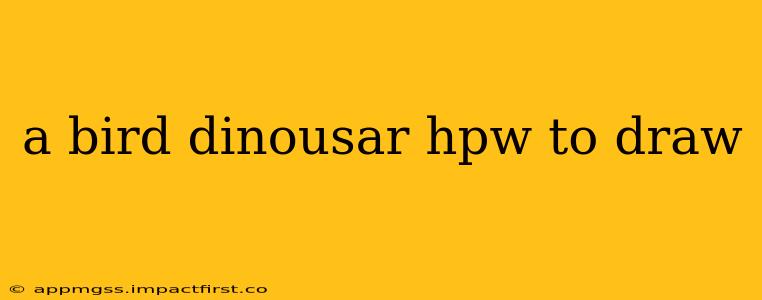The term "bird dinosaur" is often used to describe feathered dinosaurs, particularly those closely related to modern birds. Drawing one involves combining reptilian and avian features. This guide will walk you through creating a captivating feathered dinosaur, suitable for various skill levels.
Understanding the Anatomy of a Bird Dinosaur
Before we begin sketching, it's crucial to understand the unique anatomy of these fascinating creatures. Bird dinosaurs, like Archaeopteryx or Microraptor, possessed a mix of reptilian and avian characteristics. Think of a dinosaur with feathers, a long tail, and possibly teeth. They weren't exactly like modern birds, but shared many skeletal features.
What features should you focus on?
- Feathers: These are a key element. Research different types of feather structures – downy feathers, flight feathers, and contour feathers – to add realism.
- Limbs: The legs will be more reptilian, perhaps with scales and powerful claws. The arms/wings, however, will show adaptation for flight or gliding depending on the species you choose. Consider the size and shape of the wings in relation to the body.
- Head: The head will be a mix. It may have a dinosaur-like snout and jaw, possibly with teeth. However, the eyes might be more bird-like, positioned on the sides of the head.
- Tail: Most bird dinosaurs had longer tails compared to modern birds. You'll need to represent that as a significant portion of the body.
- Pose: Consider dynamic poses to showcase the creature's movement. A running pose or a perched position on a branch could work well.
Step-by-Step Drawing Guide
Let's create a Microraptor-inspired feathered dinosaur. This small dinosaur is known for its four wings (feathered arms and legs).
Step 1: Basic Structure
Start with a simple skeleton-like structure. Use light pencil strokes to outline the head, body, tail, and limbs. Think of it as a simplified pose. A slightly curved spine is helpful.
Step 2: Defining the Body
Add volume to the basic structure. Round out the head, torso, and thighs. Ensure the limbs are proportionally correct to the body.
Step 3: Adding Feathers
This is the most important part! Begin adding feathers around the body, arms, and legs. Start with larger, simpler feathers, gradually adding detail. For the "wings," you'll need to use a series of long, slightly overlapping feathers arranged like a fan.
Step 4: Facial Features and Details
Add eyes, a beak (or a more reptilian snout depending on your interpretation), and any visible scales on the legs and feet. Consider adding some texture to the feathers; this can be done with small strokes or hatching.
Step 5: Refining and Shading
Refine the outline, erase unnecessary lines, and add shading to create depth and realism. Remember to think about where the light source is coming from and how it would affect the feathers.
Frequently Asked Questions (FAQ)
What materials do I need to draw a bird dinosaur?
You'll primarily need pencils (H, 2B, 4B are good choices), an eraser, and paper. Colored pencils or paints can be used for a more colorful final result.
How do I draw realistic-looking feathers?
Start with the central shaft and branch outwards with smaller strokes representing barbules. Refer to images of real bird feathers for inspiration. Experiment with creating different types of feathers, from long flight feathers to fluffy down.
Are there any specific dinosaur species that are easier to draw for beginners?
Archaeopteryx, with its relatively simple design and mix of reptilian and avian features, is a great starting point. Compsognathus, another small, feathered dinosaur, also presents a less complex challenge than larger species.
Where can I find references to help me draw bird dinosaurs?
Many scientific illustrations and reconstructions of feathered dinosaurs are available online. Museums often have excellent displays of dinosaur fossils, including those with preserved feathers. Scientific journals and documentaries can also be useful references.
Remember, practice makes perfect. Start with simple sketches, gradually adding detail as your skills improve. Experiment with different poses and feather designs to develop your own unique style. Don't be afraid to make mistakes; that's how you learn!
